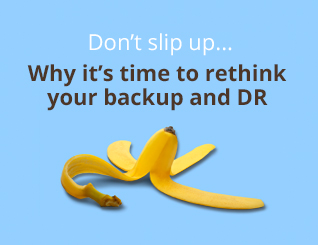Backup and recovery isn’t awfully exciting. It’s easy to neglect it, especially if it still works and it’s got enough capacity. But, if you’ve had your backup and recovery in place for a few years, it was probably designed when IT environments and requirements were very different than they are now. Today, in a very different world, it’s time to review your backup and recovery.
A decade ago, which is probably when your backup and recovery vendor did its primary design work, IT was mostly on-premise. Their solutions were designed for organisations with servers and storage in an on-site data centre, that were backed up to disk, tape or a combination. Tapes were rotated and taken off-site for remote storage, and if you had the budget you’d have a second data centre acting as a disaster recovery (DR) site, with some kind of active failover if you needed to be sure you could get up and running quickly.
Since then, the cloud has transformed the way IT is delivered, virtualisation has become commonplace, driving server utilisation rates up to a point at which backup efficiency can be compromised, and converged architectures have been added to the mix. If you have some workloads in a public cloud, some in private cloud, and probably still some on-premise, how can you ensure that everything is being backed up properly?
New demands for backup and DR
There has been an obvious explosion in the volume of data that organisations need to store, which puts new demands on backup. The Internet of Things (IoT), Big Data and DevOps initiatives will add further to this.
More data, as well as a shift more towards 24 x 7 operations, has meant that the old concept of a ‘backup window’ has become difficult to maintain. No longer is it possible to freeze everything for eight hours overnight while the backup finishes. Instead, you need continuous ‘trickle feed’ background backup, as well as ‘snapshotting’ to keep everything synced without needing a specific window of operation.
The growth in security threats and ransomware attacks mean there is an ever-increasing need for better security, including encryption at rest and in transit. A recent survey by Disaster Recovery Journal and Forrester reported that a staggering 62% of respondents had experienced a critical risk event in the last three years.
Since some of these attacks target backup as well as production data, we need immutable backup data, that cannot be changed by a ransomware exploit. We also need the ability to restore data quickly following an attack – if it takes days to bring your systems back, your organisation is in serious trouble.
As well as bulk restores, there is a growing need to easily search and recover specific data. In particular this has been driven by data protection laws, such as GDPR, and the need to respond to subject access requests.
With all these demands, IT teams are being asked to do more with the same number of people. This means that your systems need to be easy to manage and low-touch, minimising the time required.
Evolving technology
So, what has changed, and how can newer technology help you upgrade your backup and DR?
For a start, the plummeting cost of cloud storage now means it’s a viable option for backing up large amounts of data, including the long-term archives that used to be only practical to store on tape – which meant retrieving files was slow and cumbersome, manual handling was needed, and there was always a risk of media corruption.
Cloud backup is often best paired with an on-site solution, so you have immediate, fast backups on site combined with the security of an off-site copy of your data. A backup appliance, installed in your data centre, meets this need for local backup. Increasingly this is being delivered as-a-service with ongoing management and monitoring to ensure that everything’s working properly. I particularly like Rubrik’s backup technology, and as one of only two visionary vendors in Gartner’s most recent (2017) Magic Quadrant for Data Center Backup and Recovery Solutions, I’m clearly not the only one!
I must confess that this is something we do for our customers and this can include sophisticated recovery capabilities, including the option of restoring directly into the Microsoft Azure cloud – so, if you lose your primary site, you can get up and running very quickly.
Time to review your strategy
The IT world is very different today, and that means it’s time to review your backup and recovery. You need a solution that’s secure, reliable, and cost-effective, and that can cope with a mixed environment including on-premise and cloud systems, as well as virtualised and legacy equipment. It must ensure you can always recover your data after a security breach or technical failure, as well as provide fast, flexible search and restore capabilities.
All of this has to be delivered when IT teams are being asked to handle more and more tasks – which means it can make sense to turn to a service provider to help plan your backup strategy and provide day to day management.
If you’d like to review your backup and recovery strategy speak to your account manager, contact us and/or take a look at Total Backup and DR.


